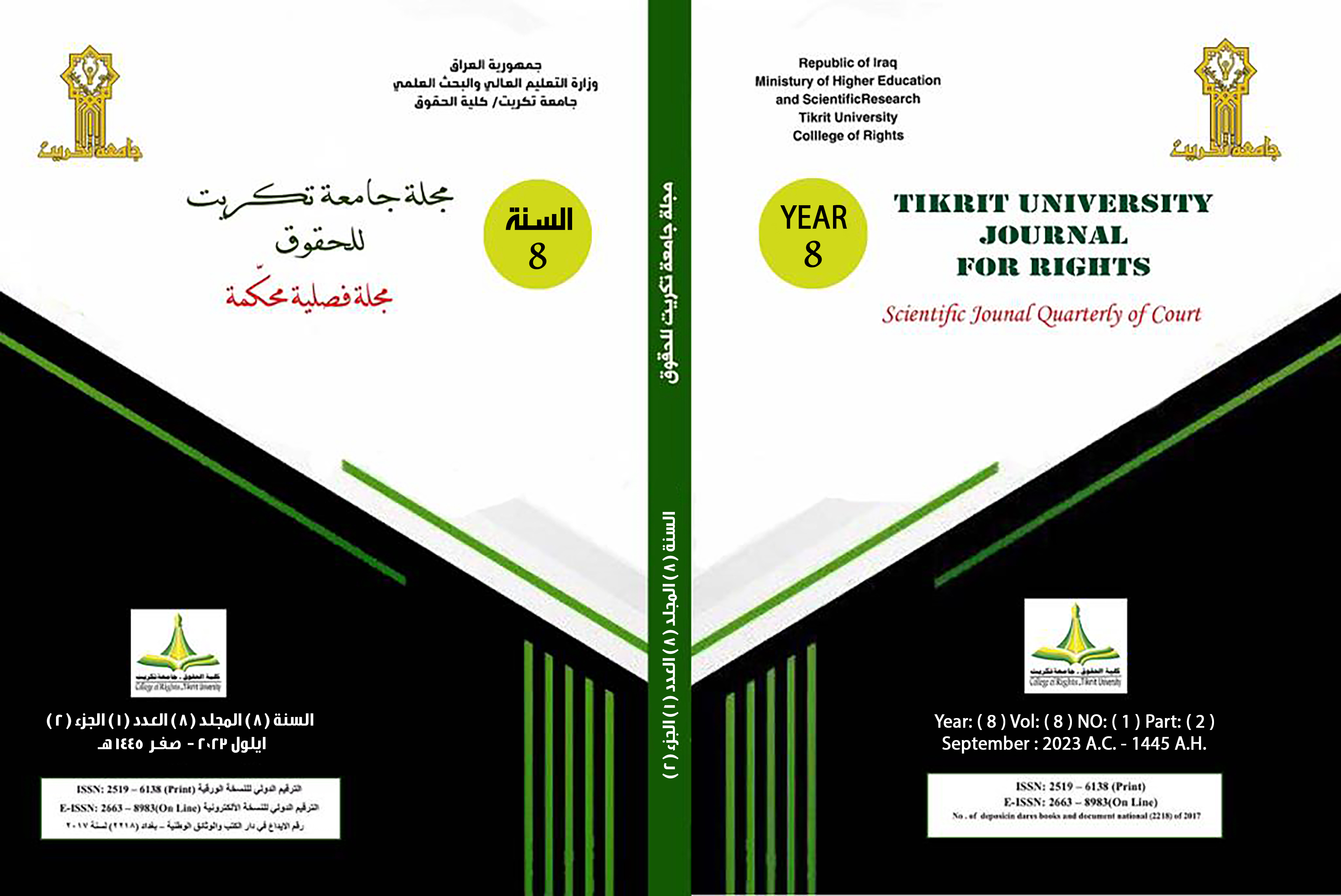The role of international custom in maritime boundary delimitation between riparian states
الكلمات المفتاحية:
- Maritime borders. - International law of the sea. - International custom. - Demarcation of maritime borders.الملخص
Abstract: The rules of international maritime law were primarily formed and developed through customary rules, which later evolved into codified texts of custom. Consequently, these codified texts of customary law are binding on all states, whether they have ratified the conventions or not, because the source of obligation lies in the sense of obligation. In contrast, newly created texts that have not yet become customary law only bind the states that have ratified the conventions. Since the late 1940s and early 1950s, with the rapid advancement of deep-sea technology, whether within the Exclusive Economic Zone or beyond it, numerous complex disputes have arisen among coastal and distant states regarding the exploitation of these resources and the delimitation of boundaries, sovereignty, and authorities in many of these areas. As a result, various international agreements did not cover many elements of these new developments, necessitating the use of customary international law to address the deficiencies in resolving crises and disputes concerning the delimitation of maritime boundaries and the exploitation of marine resources.
المراجع
- Dr. Issam Al-Attiyah, Public International Law, 5th edition, Baghdad University Press, Baghdad, 1992.
- Mabkhouta Ahmed, Successive Developments on International Custom as a Source of International Law, research published in the Journal of Law and Human Sciences, Volume 14, Issue 1, 2021, Ahmed Bin Yahya Al-Wancharisi University, Tissemsilt, Algeria.
https://www.asjp.cerist.dz/en/downArticle/315/14/1/149162
- Dr. Salah Al-Deir Amer, Introduction to Public International Law, Dar Al-Nahda Al-Arabiya, Abdel Khaleq Tharwat Street, 2007.
- PHILIP ALLOTT, POWER SHARING IN THE LAW OF THE SEA, A.J.I.L, VOL.77,1983.
- Dr. Ali Ibrahim, The General Theory of International Borders, with a special study of the problem of the border between Iraq and Kuwait and its planning in accordance with Security Council Resolution No. (687) of 1991, first edition, Dar Al-Nahda Al-Arabiya, Cairo, 1997.
- Yoshifumi Tanaka, Predictability and Flexibility in the Law of Maritime Delimitation, 2006. Oxford and Portland, Oregon, Published in North America (US and Canada) by Hart Publishing, ISBN 10: 1-84113-581-X (hardback).
- L Caflisch, ‘The Delimitation of Marine Spaces between States with Opposite and Adjacent Coasts’ in R-J Dupuy and D Vignes, (eds), A Handbook on the New Law of the Sea (Dordrecht, Nijhoff, 1991)
- M Dupuy, Droit international public, 5e edn (Paris, Dalloz, 2000).
- Thomas Cottier, Equitable Principles of Maritime Boundary Delimitation, Cambridge, United Kingdom, First Published, 2015.
- The Guinea/Guinea-Bissau case, (1985) 89 RGDIP 509, para 50. French Journal of Public International Law, Volume No. 89, Page 509, Para No. 50 in which the Guinea/Bissau case was discussed.
- Dr. Amr Ezzat Al-Haw, Settlement of Exclusive Economic Zone Disputes between Traditional and Modern Means, Journal of Security and Academic Sciences, Sharjah, United Arab Emirates, Issue Thirty-Seven of 2022 - Part Three.
- P. Chandrasekhara Rao, DELIMITATION DISPUTES UNDER THE UNITED NATIONS CONVENTION ON THE LAW OF THE SEA: SETTLEMENT PROCEDURES, LEIDEN/BOSTON, 2007, Martinus Nijhoff Publishers and VSP. , ISBN 978 90 04 16156 6, pp878-879>.
- MARTIN LISHEXIAN LEE, The Interrelation Between the Law of the Sea Convention and Customary International Law,
https://digital.sandiego.edu/cgi/viewcontent.cgi?article=1188&context=ilj
- Dr. Abdel Karim Alwan, The Mediator in Public International Law (Book Two), Contemporary International Law, Dar Al-Thaqafa for Publishing and Distribution, Amman, 2007.
- Bogdan Aurescu and Nilufer Oral, Co-Chairs of the Panel on Sea Level Rise from the Perspective of International Law, Sea Level Rise from the Perspective of International Law, Additional Paper to Issue Paper I 2020, International Law Commission, Seventy-Fourth Session, 2023.
- Mouton, M.W, The Continental Shelf, R.C.A.D.I, vol.85,1954, pp. 420- 422.
- Dr. Karim Muhammad Ragab Al-Sabbagh, Fair and Reasonable Division of Oil and Gas Fields in the Eastern Mediterranean, research published in the Damietta Law Journal for Legal and Economic Studies - Faculty of Law - Damietta University, Arab Republic of Egypt, Issue 3, January, 2021.
- Nasila S. Rembe, Africa and the international law of the sea, a study of the contribution of the
African States to the third unite nations conference on the law of the sea, University of The Dar el Salaam, Tanzania Sijthoff & Noordhoff 1980.
- The South China Sea Arbitration (The Republic of the Philippines v. The People's Republic of China),
https://pca-cpa.org/en/cases/7/
- Millicent McCreath, Zoe Scanlon, Altmetric Original Articles, The Dispute Concerning the Delimitation of the Maritime Boundary Between Ghana and Côte d'Ivoire: Implications for the Law of the Sea. https://www.tandfonline.com/doi/full https://doi.org/10.1080/00908320.2018.1548425/10.1080/00908320.2018.1548425
- Dr. Ali Sadiq Abu Haif, Public International Law, Mansha’at Al-Ma’arif, Alexandria, 5th edition, 1961.
- Barbara Kwiatkowska, The Eritrea-Yemen Arbitration: Landmark Progress in the Acquisition of Territorial Sovereignty and Equitable Maritime Boundary Delimitation, Ocean Development & International Law, Volume 32, 2001 - Issue 1, https://www.tandfonline.com/doi /abs/10.1080/00908320150502177
INTERNATIONAL TRIBUNAL FOR THE LAW OF THE SEA, Dispute concerning delimitation of the maritime between the boundary Bangladesh and Myanmar in the Bay of Bengal (Bangladesh/Myanmar) https://www.itlos.org/fileadmin/itlos/documents/cases/ case_no_16/published/C16-J-14_mar_12.pdf





